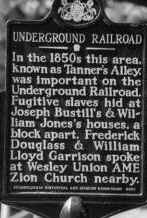
Study Areas
Anti-Slavery
Underground Railroad Sites Near Harrisburg
Union Canal House, Union Deposit
A local newspaper article (The Patriot-News, October 7, 2003, page East-6) reported that, according to local legend, the Union Canal House was an Underground Railroad station, focusing on the subterranean tunnel that connects the historic structure, now a restaurant, with Fort Swatara, across the street. No known evidence supports this claim. The structure is, however, in a location that could have been part of an Underground Railroad route. We know that fugitives sometimes used canals as a means of transportation while fleeing north, and the Union Canal connected the towns of Middletown and Pine Grove, both of which had Underground Railroad stations. Furthermore, accounts from Harrisburg document that freedom seekers were sometimes sent to Pine Grove, making Union Deposit a logical stop on that route. Samuel S. Rutherford identified the route north from his ancestor's farms, writing "guides would conduct them on to the next station, which was on a farm near Linglestown, then on to Harpers Tavern, Lickdale, Pine Grove, Pottsville and north to Canada." (Samuel S. Rutherford, "The Under Ground Railroad," in Publications of the Historical Society of Dauphin County, Harrisburg, 1928, page 3.)
Joseph Meese Farm, Linglestown
Historian Nevin Moyer identified the Joseph Meese Farm as an Underground Railroad station. The village of Linglestown was a documented stop on the Underground Railroad and was apparently the first stop after the Rutherford Family farms in Swatara and Lower Paxton Townships. See the route identified by Samuel S. Rutherford, above. Moyer identifies the farm of his birth as the historic site:
I will have to take you to the large 140-acre farm, the first farm east of Linglestown where I was born. There my parents, the B.F. Moyers, as well as my grandparents and great grandparents, Joseph and Henry Meese (Mease, Miese) lived. It was on this farm that Andrew Berryhill lived when he was killed by the Indians, and the rest of the family escaped through the wilderness to Fort Hunter. Andrew Berryhill is buried behind his old house, with others of the family and the graves are not marked. His son, Alexander, became one of the early burgess’ of Harrisburg in which city there are a hill and a street named for this family. We read, in our early history of Dauphin County, of the famous Battalion Drill ground, at Linglestown. The noted drill ground is on this farm. Here, too, was an underground railroad depot, the home of Frances Wenrich and Colonel John Umberger. ("An Interview with Nevin B. Moyer by Galen Frysinger, Paxton Rangers Historic Association, Lower Paxton High School," in The Junior Historian III/3 [February 1946], Harrisburg. Reprinted on the Internet as "Nevin Moyer, of Linglestown, Pennsylvania, USA," Galen Frysinger, http://www.galenfrysinger.ws/nevin_moyer.htm, accessed July 31, 2005.)
The farm's
owner in the period of Underground Railroad activity was Joseph
Meese (1810 - 1882), Moyer's grandfather. In 1850, Meese
worked the farm with his wife Sarah, four daughters aged 3 to 16
years, and two teenaged farmhands. One of those daughters
was Catherine (Kate) born in 1842 and mother of Nevin W.
Moyer. It is likely that Moyer, a respected local
historian, learned the Underground Railroad history of the farm
from his mother, who probably witnessed, if not took part in,
such activities, lending credibility to Moyer's statement. (1850
Census, Lower Paxton Township, Dauphin County, Pennsylvania; Lower
Paxton Township, Pennsylvania, 1767-1967, Harrisburg,
1967, pp. 126, 174.)
Click here for a detailed description of the Meese Farm written in 1913 by Nevin Moyer.
AME Church, Middletown
Historian G. Craig Caba, in a talk before the Camp Curtin Historical Society in February 2002, noted that the African Methodist Episcopal Church in Middletown had been involved with hiding fugitive slaves. Middletown had a small but politically active African American population, and an anti-slavery society had been formed in the town as early as 1837 (see the chronology page). Some local white leaders, notably George Fisher, were friendly to the abolitionist cause.
Harrisburg's Wesley Union AME Church, which actively supported local Underground Railroad activities (see Judystown), had close connections with the Middletown church, making this claim highly possible.
 Covering
the history of African Americans in central Pennsylvania from
the colonial era through the Civil War.
Covering
the history of African Americans in central Pennsylvania from
the colonial era through the Civil War.
Support the Afrolumens Project. Read the books:
The Year of Jubilee, Volume One: Men of God, Volume Two: Men of Muscle

